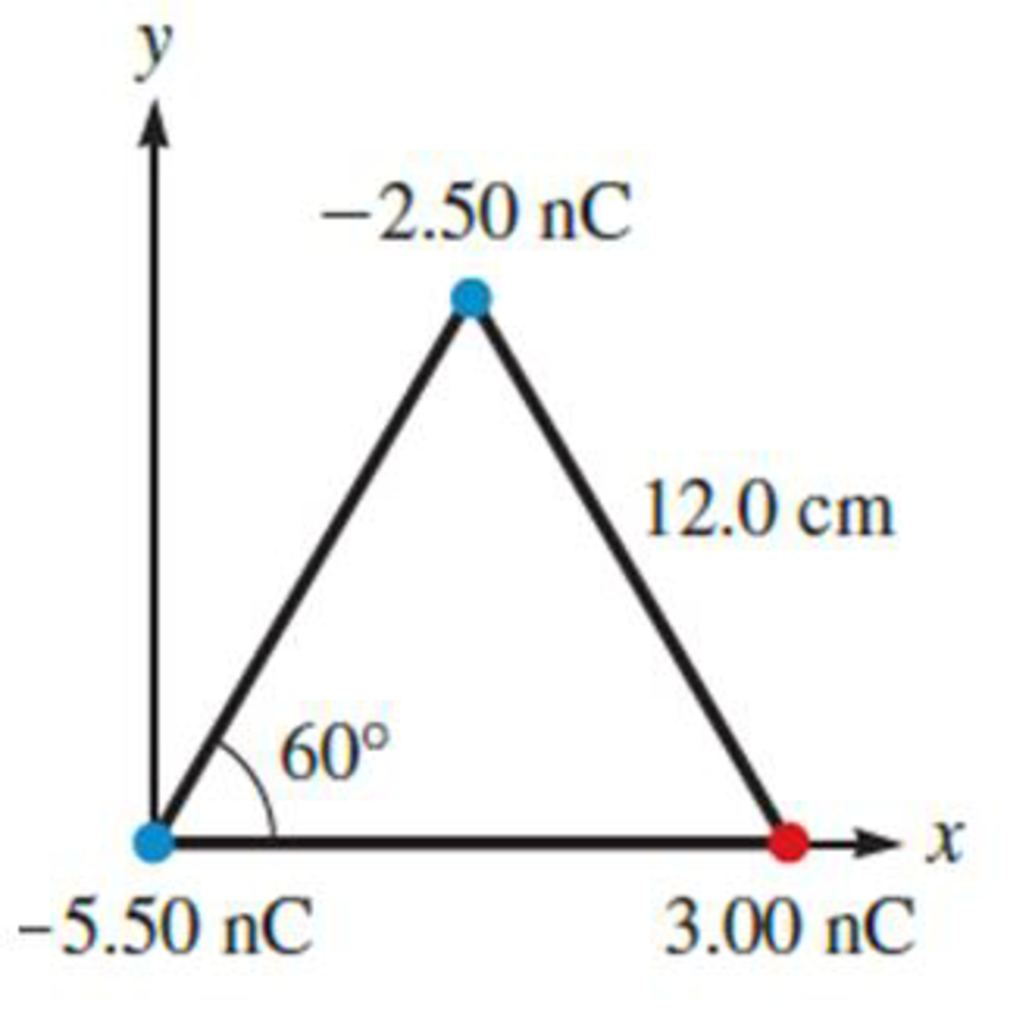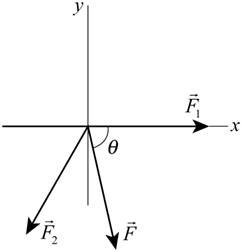
Concept explainers
Three charged metal spheres are arrayed in the xy plane so that they form an equilateral triangle (Fig. P23.40). What is the net electrostatic force on the sphere at the origin?

Figure P23.40
The net electrostatic force on the sphere at the origin.
Answer to Problem 40PQ
The net electrostatic force on the sphere at the origin is
Explanation of Solution
The diagram for the forces on charge on the origin.

Write the expression for Coulomb’s law.
Here,
Substitute
The magnitude of the force on charge
Substitute
The magnitude of the force on charge
Write the expression to find the net electrostatic force on sphere at origin.
Here,
Write the expression to find the x-component of net electrostatic force on sphere at origin.
Substitute
Write the expression to find the y-component of net electrostatic force on sphere at origin.
Substitute
Conclusion:
Substitute
Thus, the net electrostatic force on the sphere at the origin is
Want to see more full solutions like this?
Chapter 23 Solutions
Webassign Printed Access Card For Katz's Physics For Scientists And Engineers: Foundations And Connections, 1st Edition, Single-term
- Given the arrangement of charged particles shown in Figure P23.37, find the net electrostatic force on the 5.00-nC charged particle located at the origin. Figure P23.37arrow_forwardIn Figure P24.49, a charged particle of mass m = 4.00 g and charge q = 0.250 C is suspended in static equilibrium at the end of an insulating thread that hangs from a very long, charged, thin rod. The thread is 12.0 cm long and makes an angle of 35.0 with the vertical. Determine the linear charge density of the rod. FIGURE P24.49arrow_forwardCharges A, B, and C are arranged in the xy plane with qA = 5.60 C, qB = 4.00 C, and qC = 2.30 /C (Fig. P23.43). What are the magnitude and direction of the electrostatic force on charge B? Figure P23.43arrow_forward
- A conducting rod carrying a total charge of +9.00 C is bent into a semicircle of radius R = 33.0 cm, with its center of curvature at the origin (Fig.P24.75). The charge density along the rod is given by = 0 sin , where is measured clockwise from the +x axis. What is the magnitude of the electric force on a 1.00-C charged particle placed at the origin?arrow_forwardThree charged particles are arranged in the xy plane as shown in Figure P23.61, with qA = 6.40 C, qB = 2.30 C, and qC = 3.80 C. What is the net electrostatic force on the particle with charge qA? Figure P23.61arrow_forwardA Figure P23.65 shows two identical conducting spheres, each with charge q, suspended from light strings of length L. If the equilibrium angle the strings make with the vertical is , what is the mass m of the spheres? Figure P23.65arrow_forward
- A uniform electric field given by E=(2.655.35j)105N/C permeates a region of space in which a small negatively charged sphere of mass 1.30 g is suspended by a light cord (Fig. P24.53). The sphere is found to be in equilibrium when the string makes an angle = 23.0. a. What is the charge on the sphere? b. What is the magnitude of the tension in the cord? FIGURE P24.53arrow_forwardWhy is the following situation impossible? A solid copper sphere of radius 15.0 cm is in electrostatic equilibrium and carries a charge of 40.0 nC. Figure P24.30 shows the magnitude of the electric field as a function of radial position r measured from the center of the sphere. Figure P24.30arrow_forwardFigure P24.16 shows three charged particles arranged in the xy plane at the coordinates shown, with qA = qB = 3.30 nC and qC = 4.70 nC. What is the electric field due to these particles at the origin? FIGURE P24.16arrow_forward
- In the uniform charge distribution shown in Figure P23.56, each of the three arcs forms one-fourth of the circumference of a ring. The upper right and lower left arcs each carry a positive charge q. while the upper left arc carries a charge -q. Determine the elec- tric field at P, the ring center, in terms of q and R. . Figure P23.56arrow_forwardThree point charges are located at the corners of 7.00 µC an equilateral triangle as in Figure P15.13. Find the magnitude and direction of \0.500 m the net electric force on the 60.0° 2.00 µC charge.arrow_forwardTwo small beads having positive charges q1 = 3q and q2 = q are fixed at the opposite ends of a horizontal insulating rod of length d = 1.50 m. The bead with charge q1 is at the origin. As shown in Figure P15.66, a third small charged bead is free to slide on the rod. At what position x is the third bead in equilibrium?arrow_forward
 Physics for Scientists and Engineers: Foundations...PhysicsISBN:9781133939146Author:Katz, Debora M.Publisher:Cengage Learning
Physics for Scientists and Engineers: Foundations...PhysicsISBN:9781133939146Author:Katz, Debora M.Publisher:Cengage Learning Physics for Scientists and EngineersPhysicsISBN:9781337553278Author:Raymond A. Serway, John W. JewettPublisher:Cengage Learning
Physics for Scientists and EngineersPhysicsISBN:9781337553278Author:Raymond A. Serway, John W. JewettPublisher:Cengage Learning Physics for Scientists and Engineers with Modern ...PhysicsISBN:9781337553292Author:Raymond A. Serway, John W. JewettPublisher:Cengage Learning
Physics for Scientists and Engineers with Modern ...PhysicsISBN:9781337553292Author:Raymond A. Serway, John W. JewettPublisher:Cengage Learning


